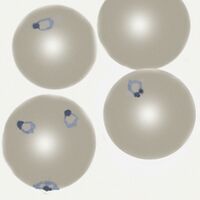Plasmodium falciparum: Morphology: Difference between revisions
From haematologyetc.co.uk
No edit summary |
No edit summary |
||
| Line 30: | Line 30: | ||
*Parasites may appear on the [[Accolé form|edge of the red cell]] and have a flattened appearance (accolé forms) | *Parasites may appear on the [[Accolé form|edge of the red cell]] and have a flattened appearance (accolé forms) | ||
*Affected red cells have [[Size and shape of infected red cells|normal size]] and haemoglobin content | *Affected red cells have [[Size and shape of infected red cells|normal size]] and haemoglobin content | ||
<div style="width: 300px"> | <div style="width: 300px"> | ||
{| class="wikitable" style="border-left:solid 4px gray;border-right:solid 4px gray;border-top:solid 4px gray;border-bottom:solid 4px gray; font-size:90%; color:navy" | {| class="wikitable" style="border-left:solid 4px gray;border-right:solid 4px gray;border-top:solid 4px gray;border-bottom:solid 4px gray; font-size:90%; color:navy" | ||
| colspan="1"''|[[ | | colspan="1"''|[[P.falciparum early trophozoites gallery|Click for gallery]]'' | ||
|} | |} | ||
</div> | </div> | ||
Revision as of 14:31, 14 March 2024
Geographical distribution
P.falciparum infection occurs in tropical and subtropical areas of central and South America, Africa, and S.E.Asia; this resembles the distribution of P.malariae and overlaps but is distinct from the distribution of P.vivax and P.ovale.
Detailed geographical information may be accessed here: [1].
The early trophozoite
The earliest developing stage, and often the only form present in this species:
- Ring forms that are fine and delicate
- Frequently the red cells contain multiple parasites
- Parasites may have a distinctive double chromatin dot (signet ring form)
- Parasites may appear on the edge of the red cell and have a flattened appearance (accolé forms)
- Affected red cells have normal size and haemoglobin content
The late trophozoite
rleft
The later developing stage:
- Parasites resemble early ring forms, but thicker and slightly larger
- Additional dots and clefts in cytoplasm when stained correctly (blue and relatively low in number).
- These are Maurer's dots and clefts
- Size and shape of infected red cells usually unaffected, but may become crenated
- Look for double chromatin dot, Accolé forms, multiple parasites/cell
The schizont
The asexual replication stage:
- Do not generally circulate in this species unless overwhelming infection
- Contain multiple asexually formed developing parasites (most frequently 8-16)
- Development is progressive: first there are multiple chromatin dots, later a distinct nucleus and cytoplasm appears
- Loose pigment may be seen in clumps between the parasites
- Red cell size is generally unaffected but haemoglobin will largely be absent (metabolised by the parasites)
The gametocyte
The sexual replication stage (very distinctive).
- Gametocytes are elongated but are also restricted by the red cell membrane
- They appear as straight rods but frequently curve into a “banana form”
- The residual membrane (empty of haemoglobin) may appear as a "blister" to the side of the parasite
- The single chromatin area is in the centre of the parasite, often pigment overlies or surrounds it
- Gametocytes may not be seen in many cases.
Gallery
Click here to see gallery of Plasmodium falciparum forms

